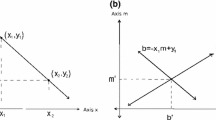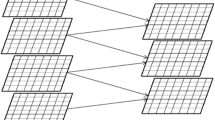Abstract
The integral histogram for images is an efficient preprocessing method for speeding up diverse computer vision algorithms including object detection, appearance-based tracking, recognition and segmentation. Our proposed Graphics Processing Unit (GPU) implementation uses parallel prefix sums on row and column histograms in a cross-weave scan with high GPU utilization and communication-aware data transfer between CPU and GPU memories. Two different data structures and communication models were evaluated. A 3-D array to store binned histograms for each pixel and an equivalent linearized 1-D array, each with distinctive data movement patterns. Using the 3-D array with many kernel invocations and low workload per kernel was inefficient, highlighting the necessity for careful mapping of sequential algorithms onto the GPU. The reorganized 1-D array with a single data transfer to the GPU with high GPU utilization, was 60 times faster than the CPU version for a 1K ×1K image reaching 49 fr/sec and 21 times faster for 512×512 images reaching 194 fr/sec. The integral histogram module is applied as part of the likelihood of features tracking (LOFT) system for video object tracking using fusion of multiple cues.
Access this chapter
Tax calculation will be finalised at checkout
Purchases are for personal use only
Preview
Unable to display preview. Download preview PDF.
Similar content being viewed by others
References
Porikli, F.: Integral histogram: A fast way to extract histograms in cartesian spaces. In: IEEE CVPR, vol. (1), pp. 829–836 (2005)
Sizintsev, M., Derpanis, K.G., Hogue, A.: Histogram-based search: A comparative study. In: IEEE CVPR, pp. 1–8 (2008)
Viola, P., Jones, M.J.: Robust real-time face detectin. Int. J. Computer Vision 57, 137–154 (2004)
Wei, Y., Tao, L.: Efficient histogram-based sliding window. In: IEEE CVPR, pp. 3003–3010 (2010)
Zhu, Q., Yeh, M.C., Cheng, K.T., Avidan, S.: Fast human detection using a cascade of histograms of oriented gradients. In: IEEE CVPR, vol. (2), pp. 1491–1498 (2006)
Adam, A., Rivlin, E., Shimshoni, I.: Robust fragments-based tracking using the integral histogram. In: IEEE CVPR, pp. 798–805 (2006)
Palaniappan, K., et al.: Efficient Feature extraction and likelihood fusion for vehicle tracking in low frame rate airborne video. In: 13th Conf. Information Fusion, pp. 1–8 (2010)
Pelapur, R., Candemir, S., Bunyak, F., Poostchi, M., Seetharaman, G., Palaniappan, K.: Persistent target tracking using likelihood fusion in wide-area and full motion video sequences. In: 15th Int. Conf. Information Fusion, pp. 2420–2427 (2012)
Erdem, E., Dubuisson, S., Bloch, I.: Fragments Based Tracking with Adaptive Cue Integration. Computer Vision and Image Understanding (7), 827–841 (2012)
Mosig, A., Jaeger, S., Chaofeng, W., Ersoy, I., Nath, S.K., Palaniappan, K., Chen, S.S.: Tracking cells in live cell imaging videos using topological alignments. Algorithms in Molecular Biology (4), 10 (2009)
Kolekar, M.H., Palaniappan, K., Sengupta, S., Seetharaman, G.: Semantic concept mining based on hierarchical event detection for soccer video indexing. Special Issue on Multimodal Information Retrieval (4), 298–312 (2009)
Palaniappan, K., Rao, R., Seetharaman, G.: Wide-area persistent airborne video: Architecture and challenges. In: Distributed Video Sensor Networks: Research Challenges and Future Directions, pp. 349–371 (2011)
Park, I.K., et al.: Design and performance evaluation of image processing algorithms on GPUs. IEEE Parallel and Distributed Systems 22(1), 91–104 (2011)
Grauer-Gray, S., Kambhamettu, C., Palaniappan, K.: GPU implementation of belief propagation using CUDA for cloud tracking and reconstruction. In: 5th IAPR Workshop on Pattern Recognition in Remote Sensing (ICPR), pp. 1–4 (2008)
Palaniappan, K., et al.: Parallel flux tensor analysis for efficient moving object detection. In: Int. Conf. Information Fusion, pp. 1–8 (2011)
Palaniappan, K., Bunyak, F., Nath, S.K., Goffeney, J.: Parallel Processing Strategies for Cell Motility and Shape Analysis. In: High-Throughput Image Reconstruction and Analysis, vol. (3), pp. 39–87 (2009)
Kumar, P., Palaniappan, K., Mittal, A., Seetharaman, G.: Parallel Blob Extraction Using the Multi-core Cell Processor. In: Blanc-Talon, J., Philips, W., Popescu, D., Scheunders, P. (eds.) ACIVS 2009. LNCS, vol. 5807, pp. 320–332. Springer, Heidelberg (2009)
Palaniappan, K., Vass, J., Zhuang, X.: Parallel robust relaxation algorithm for automatic stereo analysis. In: SPIE Proc. Parallel and Distributed Methods for Image Processing II, vol. 3452, pp. 958–962 (1998)
Palaniappan, K., Faisal, M., Kambhamettu, C., Hasler, A.F.: Implementation of an automatic semi-fluid motion analysis algorithm on a massively parallel computer. In: 10th IEEE Int. Parallel Processing Symp., pp. 864–872 (1996)
Bellens, P., Palaniappan, K., Badia, R.M., Seetharaman, G., Labarta, J.: Parallel Implementation of the Integral Histogram. In: Blanc-Talon, J., Kleihorst, R., Philips, W., Popescu, D., Scheunders, P. (eds.) ACIVS 2011. LNCS, vol. 6915, pp. 586–598. Springer, Heidelberg (2011)
Bilgic, B., Horn, B.K.P., Masaki, I.: Efficient integral image computation on the GPU. In: IEEE Intelligent Vehicles Symposium (IV), pp. 528–5338 (2010)
Kirk, D.: Nvidia CUDA software and GPU parallel computing architecture. In: ACM Proc. 6th Int. Symp. Memory Management (ISMM), pp. 103–104 (2007)
Nvidia Corp.: CUDA C Programming Guide 4.0 (2011)
Harris, M., Sengupta, S., Owens, J.D.: Parallel prefix sum (scan) with CUDA. In: GPU Gems, vol. 3, ch. 39, pp. 851–876 (2007)
Ruetsch, G., Micikevicius, P.: Optimizing matrix transpose in CUDA Nvidia CUDA. SDK Application Note (2009)
Air Force Research Laboratory: Columbus Large Image Format (CLIF) dataset over Ohio State University (2007)
Author information
Authors and Affiliations
Editor information
Editors and Affiliations
Rights and permissions
Copyright information
© 2013 Springer-Verlag Berlin Heidelberg
About this paper
Cite this paper
Poostchi, M., Palaniappan, K., Bunyak, F., Becchi, M., Seetharaman, G. (2013). Efficient GPU Implementation of the Integral Histogram. In: Park, JI., Kim, J. (eds) Computer Vision - ACCV 2012 Workshops. ACCV 2012. Lecture Notes in Computer Science, vol 7728. Springer, Berlin, Heidelberg. https://doi.org/10.1007/978-3-642-37410-4_23
Download citation
DOI: https://doi.org/10.1007/978-3-642-37410-4_23
Publisher Name: Springer, Berlin, Heidelberg
Print ISBN: 978-3-642-37409-8
Online ISBN: 978-3-642-37410-4
eBook Packages: Computer ScienceComputer Science (R0)




